Injector FORD FIESTA 2007 Service Manual
[x] Cancel search | Manufacturer: FORD, Model Year: 2007, Model line: FIESTA, Model: FORD FIESTA 2007Pages: 1226, PDF Size: 61.26 MB
Page 837 of 1226
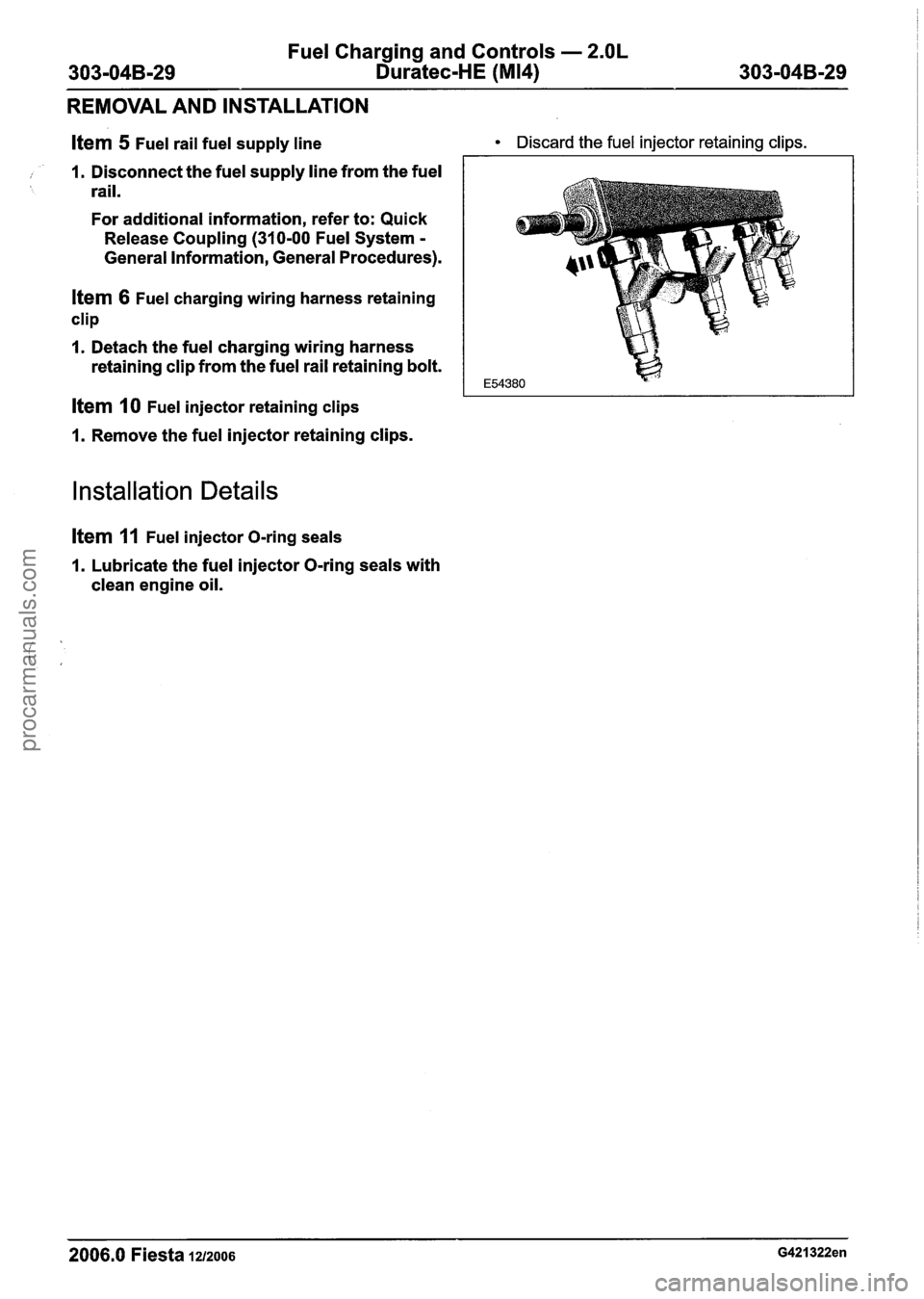
Fuel Charging and Controls - 2.OL
303-04B-29 Duratec-HE (M14) 303-04B-29
REMOVAL AND INSTALLATION
Item 5 Fuel rail fuel supply line
, 1. Disconnect the fuel supply line from the fuel rail.
For additional information, refer to: Quick
Release Coupling (310-00 Fuel System
-
General Information, General Procedures).
Item 6 Fuel charging wiring harness retaining
clip
1. Detach the fuel charging wiring harness
retaining clip from the fuel rail retaining bolt.
Item 10 Fuel injector retaining clips
1. Remove the fuel injector retaining clips.
Installation Details
item 11 Fuel injector O-ring seals
1. Lubricate the fuel injector O-ring seals with
clean engine oil.
Discard the fuel injector retaining clips.
- --
2006.0 Fiesta 1212006 G421322en
procarmanuals.com
Page 930 of 1226
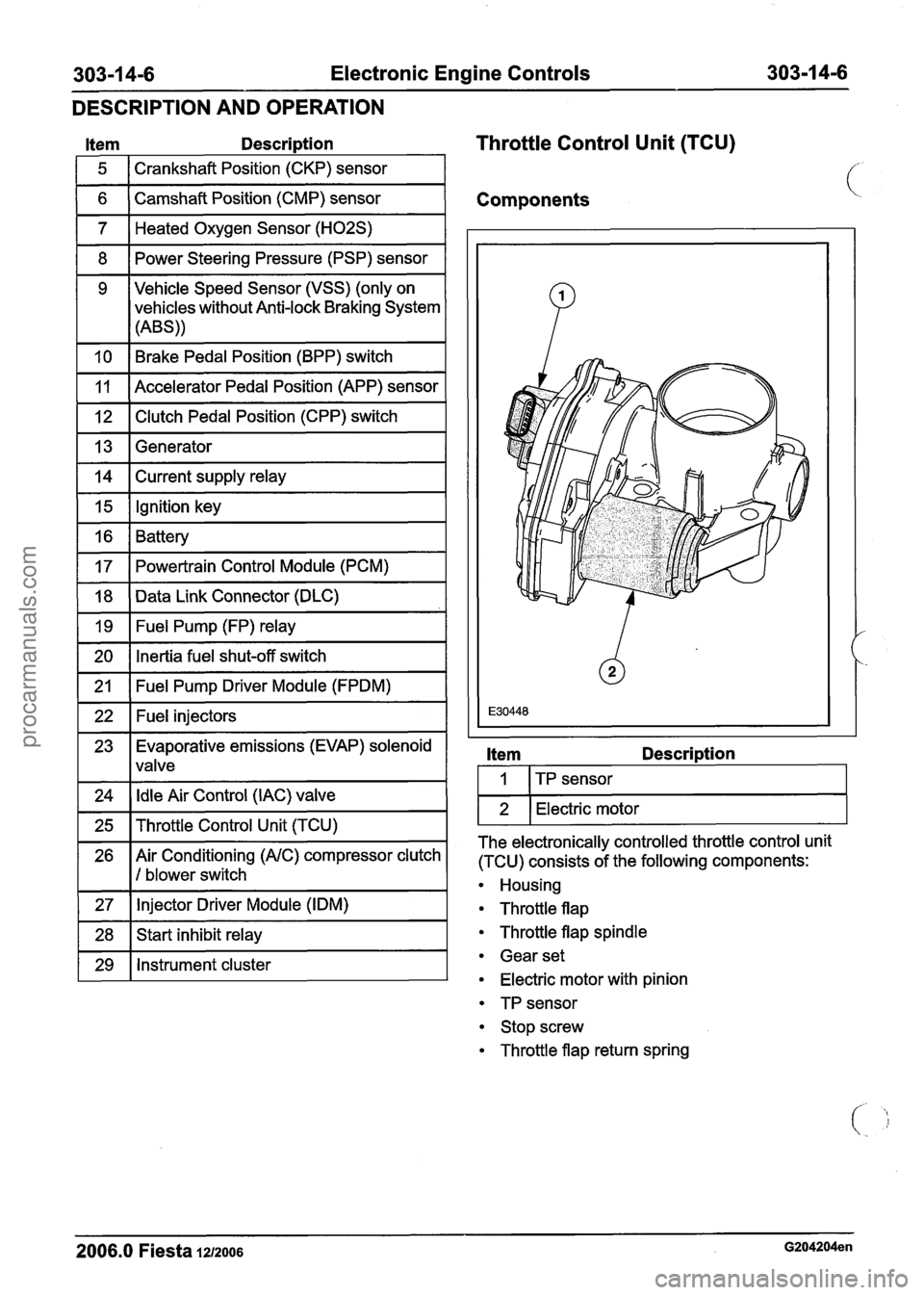
303-1 4-6 Electronic Engine Controls 303-1 4-6
DESCRIPTION
AND OPERATION
Item Descri~tion
1 5 1 Crankshaft Position (CKP) sensor 1
Throttle Control Unit (TCU)
1 6 ( Camshaft Position (CMP) sensor I Components
1 7 1 Heated Oxygen Sensor (H02S) I
1 8 1 Power Steering Pressure (PSP) sensor I
1 10 1 Brake Pedal Position (BPP) switch I
9 Vehicle Speed Sensor (VSS)
(only on
vehicles without Anti-lock Braking System
(ABS))
1 12 1 Clutch Pedal Position (CPP) switch I
11
1 13 1 Generator I
Accelerator Pedal Position (APP) sensor
1 14 1 Current supply relay I
1 15 1 Ignition key I -
16
17
1 20 1 Inertia fuel shut-off switch I
Battery
Powertrain Control Module (PCM)
-
18
19
1 21 1 Fuel Pump Driver Module (FPDM) I
Data Link Connector (DLC)
Fuel Pump (FP) relay
1 22 1 Fuel injectors I
23 Evaporative emissions (EVAP) solenoid
1 lvalve
1 24 1 Idle Air Control (IAC) valve 1
1 25 1 Throttle Control Unit (TCU) I
26 Air Conditioning (AIC) compressor clutch
1 I 1 blower switch
1 27 1 Injector Driver
Module (IDM) I
1 28 1 Start inhibit relay I
1 29 1 Instrument cluster I
Item Descri~tion
I I ITP sensor I
1 2 1 Electric motor I
The electronically controlled throttle control unit
(TCU) consists of the following components:
Housing
Throttle flap
Throttle flap spindle
Gear set
Electric motor with pinion
TP sensor
Stop screw
Throttle flap return spring
2006.0 Fiesta 1212006 G204204en
procarmanuals.com
Page 935 of 1226
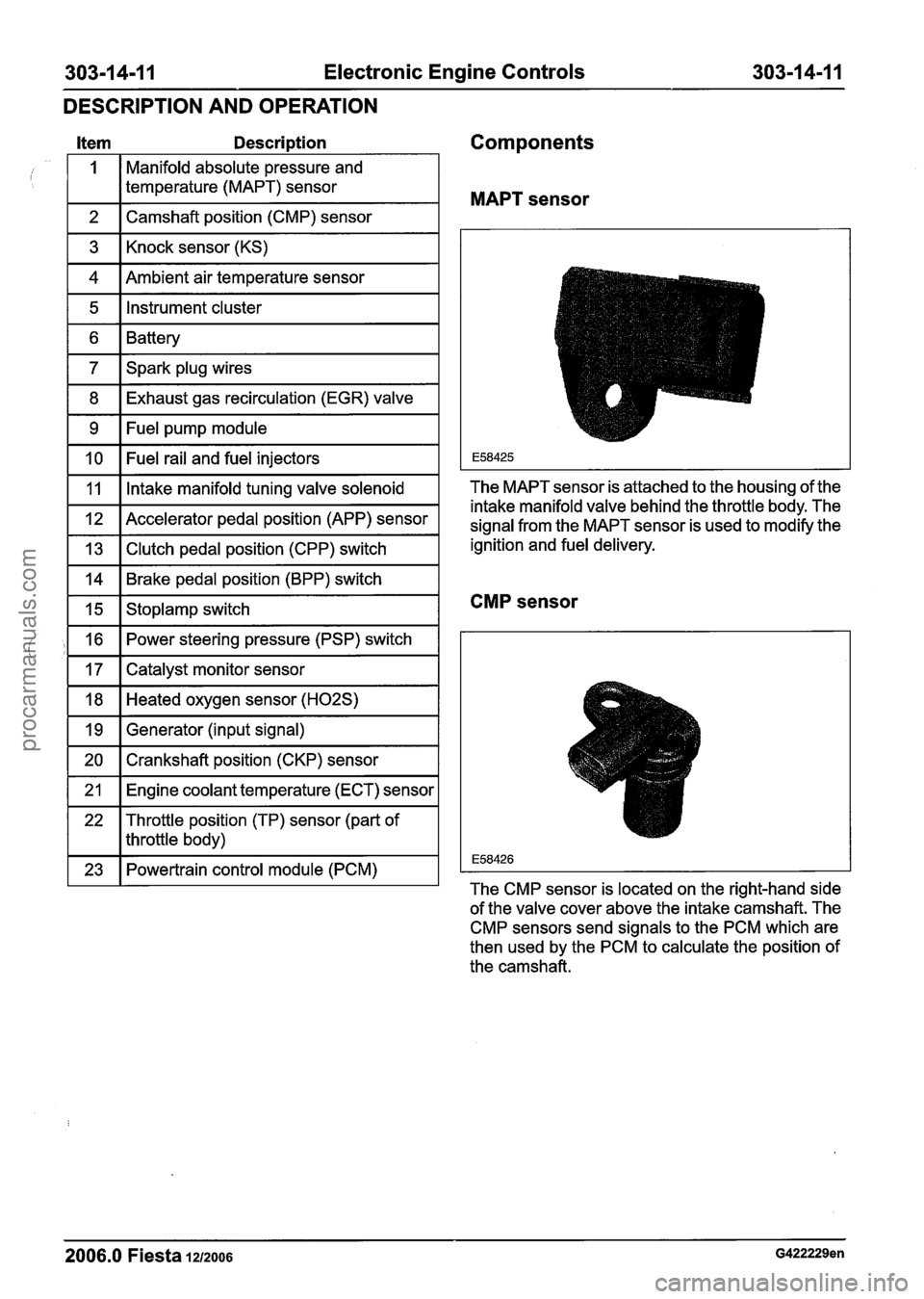
303-1 4-1 1 Electronic Engine Controls 303-1 4-1 I
DESCRIPTION AND OPERATION
Item Description Components
MAPT sensor
Manifold absolute pressure and
temperature (MAPT) sensor
1 2 1 Camshaft position (CMP) sensor I
1 3 1 Knock sensor (KS) I
vl~Ame%air temperature sensor I
1 5 1 Instrument cluster I
1 6 1 Battery I
1 7 1 Spark plug wires I
1 8 1 Exhaust gas recirculation (EGR) valve I
1 9 1 Fuel pump module I
1 10 1 Fuel rail and fuel injectors I
I 11 I Intake manifold tuning valve solenoid The
MAPT sensor is attached to the housing of the
intake manifold valve behind the throttle body. The
signal from the MAPT sensor is used to modify the
ignition and fuel delivery.
1 12 1 Accelerator pedal position (APP) sensor
1 13 1 Clutch pedal position (CPP) switch
1 14 1 Brake pedal position (BPP) switch
CMP sensor 1 15 1 Stoplamp switch
1 16 1 Power steering pressure (PSP) switch I
1 17 1 Catalyst monitor sensor I
FIGted oxygen sensor (H02S) I
1 19 1 Generator (input signal) I
1 20 1 Crankshaft position (CKP) sensor I
1 21 1 Engine coolant temperature (ECT) sensor I
22 Throttle position
(TP) sensor (part of
I I throttle body)
1 23 1 Powertrain control module (PCM) I The CMP sensor is located on the right-hand side
of the valve cover above the intake camshaft. The
CMP sensors send signals to the PCM which are
then used by the PCM to calculate the position of
the camshaft.
2006.0 Fiesta 1212006 G422229en
procarmanuals.com
Page 939 of 1226
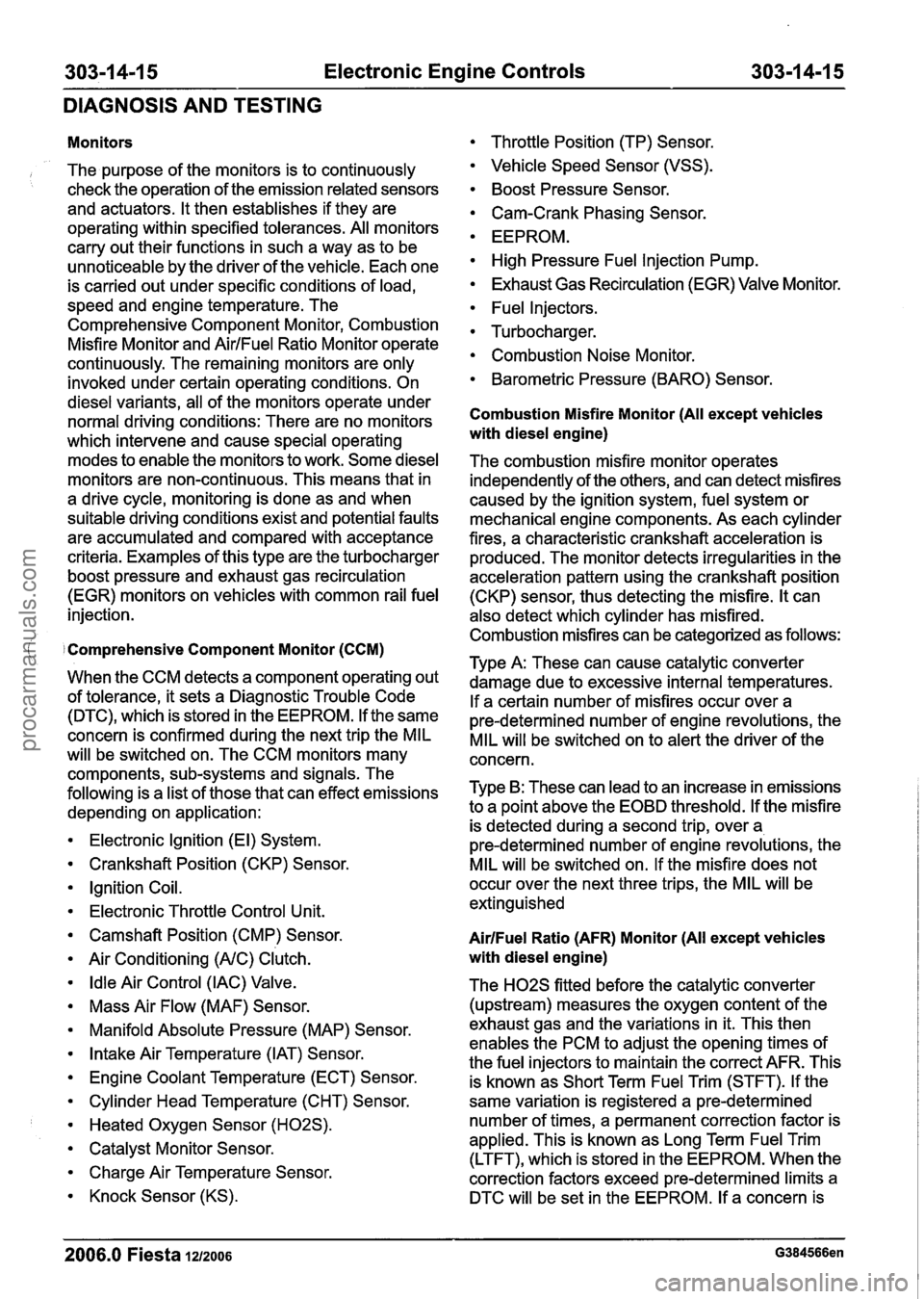
303-1 4-1 5 Electronic Engine Controls 303-1 4-1 5
DIAGNOSIS AND TESTING
Monitors
The purpose of the monitors is to continuously
check the operation of the emission related sensors
and actuators. It then establishes if they are
operating within specified tolerances. All monitors
carry out their functions in such a way as to be
unnoticeable by the driver of the vehicle. Each one
is carried out under specific conditions of load,
speed and engine temperature. The Comprehensive Component Monitor, Combustion
Misfire Monitor and
AirIFuel Ratio Monitor operate
continuously. The remaining monitors are only
invoked under certain operating conditions. On
diesel variants, all of the monitors operate under
normal driving conditions: There are no monitors
which intervene and cause special operating
modes to enable the monitors to work. Some diesel
monitors are non-continuous. This means that in
a drive cycle, monitoring is done as and when
suitable driving conditions exist and potential faults
are accumulated and compared with acceptance
criteria. Examples of this type are the turbocharger
boost pressure and exhaust gas recirculation
(EGR) monitors on vehicles with common rail fuel
injection.
( Comprehensive Component Monitor (CCM)
When the CCM detects a component operating out
of tolerance, it sets a Diagnostic Trouble Code
(DTC), which is stored in the EEPROM. If the same
concern is confirmed during the next trip the MIL
will be switched on. The CCM monitors many
components, sub-systems and signals. The
following is a list of those that can effect emissions
depending on application:
Electronic Ignition (El) System.
Crankshaft Position (CKP) Sensor.
Ignition Coil.
Electronic Throttle Control Unit.
Camshaft Position (CMP) Sensor.
Air Conditioning
(AIC) Clutch.
Idle Air Control (IAC) Valve.
Mass Air Flow (MAF) Sensor.
Manifold Absolute Pressure (MAP) Sensor.
Intake Air Temperature (IAT) Sensor.
Engine Coolant Temperature (ECT) Sensor.
Cylinder Head Temperature (CHT) Sensor.
Heated Oxygen Sensor
(H02S).
Catalyst Monitor Sensor.
Charge Air Temperature Sensor.
Knock Sensor (KS).
Throttle Position (TP) Sensor.
Vehicle Speed Sensor (VSS).
Boost Pressure Sensor.
Cam-Crank Phasing Sensor.
EEPROM.
High Pressure Fuel Injection Pump.
Exhaust Gas Recirculation (EGR) Valve Monitor.
Fuel Injectors.
Turbocharger.
Combustion Noise Monitor.
Barometric Pressure (BARO) Sensor.
Combustion Misfire Monitor (All except vehicles
with diesel engine)
The combustion misfire monitor operates independently of the others, and can detect misfires
caused by the ignition system, fuel system or
mechanical engine components. As each cylinder
fires, a characteristic crankshaft acceleration is
produced. The monitor detects irregularities in the
acceleration pattern using the crankshaft position (CKP) sensor, thus detecting the misfire. It can
also detect which cylinder has misfired.
Combustion misfires can be categorized as follows:
Type
A: These can cause catalytic converter
damage due to excessive internal temperatures.
If a certain number of misfires occur over a
pre-determined number of engine revolutions, the
MIL will be switched on to alert the driver of the
concern.
Type B: These can lead to an increase in emissions
to a point above the EOBD threshold. If the misfire
is detected during a second trip, over a,
pre-determined number of engine revolutions, the
MIL will be switched on. If the misfire does not
occur over the next three trips, the MIL will be
extinguished
AirIFuel Ratio (AFR) Monitor (All except vehicles
with diesel engine)
The H02S fitted before the catalytic converter
(upstream) measures the oxygen content of the
exhaust gas and the variations in it. This then
enables the PCM to adjust the opening times of
the fuel injectors to maintain the correct AFR. This
is known as Short Term Fuel Trim (STFT). If the
same variation is registered a pre-determined
number of times, a permanent correction factor is
applied. This is known as Long Term Fuel Trim
(LTFT), which is stored in the EEPROM. When the
correction factors exceed pre-determined limits a
DTC will be set in the EEPROM. If a concern is
2006.0 Fiesta 1212006 G384566en
procarmanuals.com
Page 940 of 1226
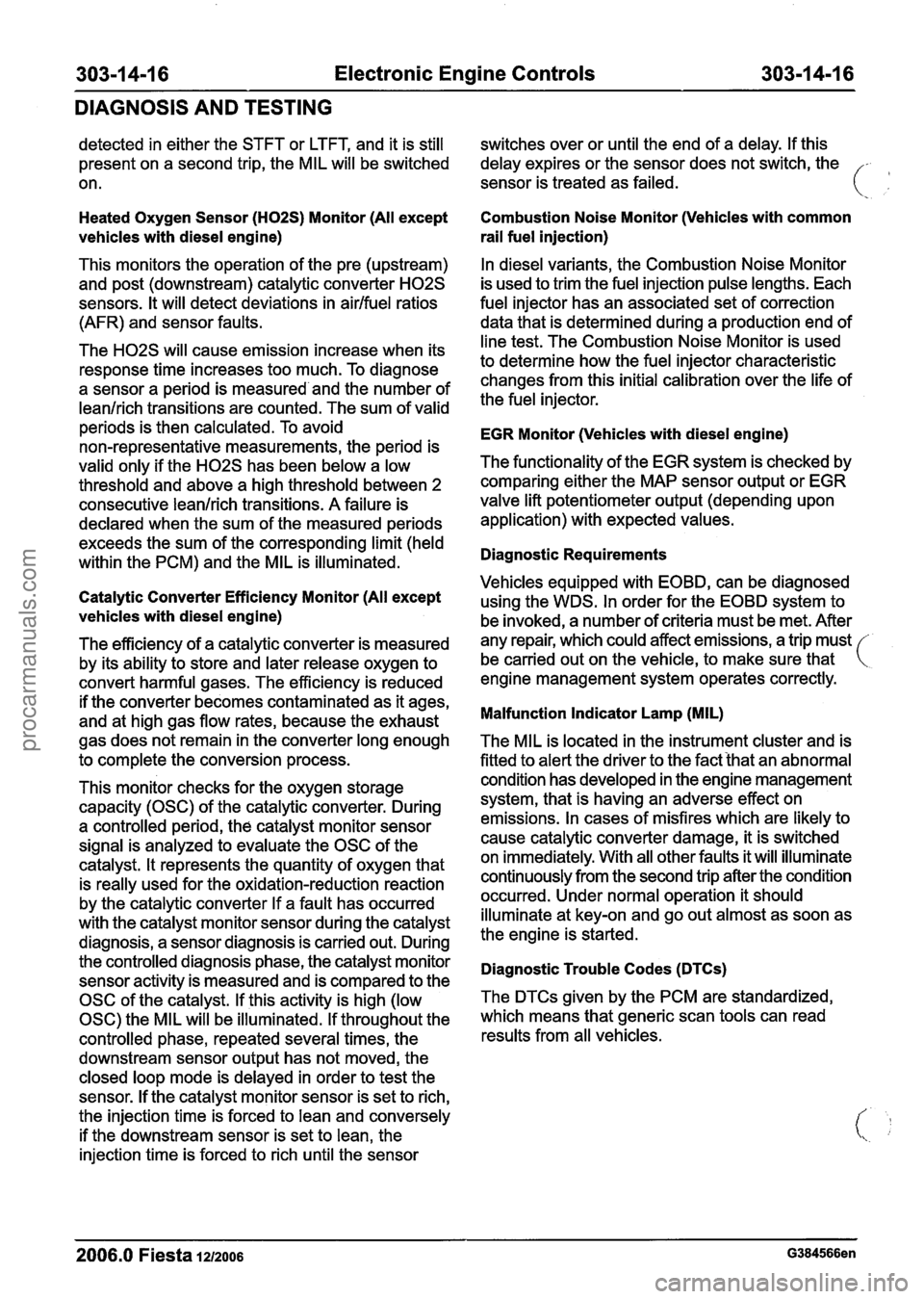
Electronic Engine Controls
DIAGNOSIS AND TESTING
detected in either the STFT or LTFT, and it is still
present on a second trip, the MIL will be switched
on.
Heated Oxygen Sensor (H02S) Monitor (All except
vehicles with diesel engine)
This monitors the operation of the pre (upstream)
and post (downstream) catalytic converter
H02S
sensors. It will detect deviations in airlfuel ratios
(AFR) and sensor faults.
The
H02S will cause emission increase when its
response time increases too much. To diagnose
a sensor a period is measured and the number of
leanlrich transitions are counted. The sum of valid
periods is then calculated. To avoid
non-representative measurements, the period is
valid only if the
H02S has been below a low
threshold and above a high threshold between 2
consecutive leanlrich transitions.
A failure is
declared when the sum of the measured periods
exceeds the sum of the corresponding limit (held
within the PCM) and the MIL is illuminated.
Catalytic Converter Efficiency Monitor (All except
vehicles with diesel engine)
The efficiency of a catalytic converter is measured
by its ability to store and later release oxygen to
convert harmful gases. The efficiency is reduced
if the converter becomes contaminated as it ages,
and at high gas flow rates, because the exhaust
gas does not remain in the converter long enough
to complete the conversion process. switches
over or until the end of a delay. If this
delay expires or the sensor does not switch, the
sensor is treated as failed.
Combustion Noise Monitor (Vehicles with common
rail fuel injection)
In diesel variants, the Combustion Noise Monitor
is used to trim the fuel injection pulse lengths. Each
fuel injector has an associated set of correction
data that is determined during a production end of
line test. The Combustion Noise Monitor is used
to determine how the fuel injector characteristic
changes from this initial calibration over the life of
the fuel injector.
EGR Monitor (Vehicles with diesel engine)
The functionality of the EGR system is checked by
comparing either the MAP sensor output or EGR
valve lift potentiometer output (depending upon
application) with expected values.
Diagnostic Requirements
Vehicles equipped with EOBD, can be diagnosed
using the WDS. In order for the EOBD system to
be invoked, a number of criteria must be met. After
any repair, which could affect emissions, a trip must
be carried out on the vehicle, to make sure that
engine management system operates correctly.
Malfunction Indicator Lamp (MIL)
The MIL is located in the instrument cluster and is
fitted to alert the driver to the fact that an abnormal
This monitor checks for the oxygen storage condition
has developed in the engine management
capacity (OSC) of the catalytic converter. During system,
that is having an adverse effect on
a controlled period, the catalyst monitor sensor emissions.
In cases of misfires which are likely to
signal is analyzed to evaluate the OSC of the cause
catalytic converter damage, it is switched
catalyst. It represents the quantity of oxygen that on immediately.
With all other faults it will illuminate
is really used for the oxidation-reduction reaction continuously
from the second trip after the condition
by the catalytic converter If a fault has occurred occurred.
Under normal operation it should
with the catalyst monitor sensor during the catalyst illuminate
at key-on and go out almost as soon as
diagnosis, a sensor diagnosis is carried out. During the
engine is started.
the controlled diagnosis phase, the catalyst monitor
Diagnostic Trouble Codes (DTCs) sensor activity is measured and is compared to the
OSC of the catalyst. If this activity is high (low The
DTCs given
by the PCM are standardized,
0SC)theMILwillbeilluminated.Ifthroughoutthe whichmeansthatgenericscantoolscanread
controlled phase, repeated several times, the results from
all vehicles.
downstream sensor output has not moved, the
closed loop mode is delayed in order to test the
sensor. If the catalyst monitor sensor is set to rich,
the injection time is forced to lean and conversely
if the downstream sensor is set to lean, the
injection time is forced to rich until the sensor
2006.0 Fiesta 1212006 G384566en
procarmanuals.com
Page 942 of 1226
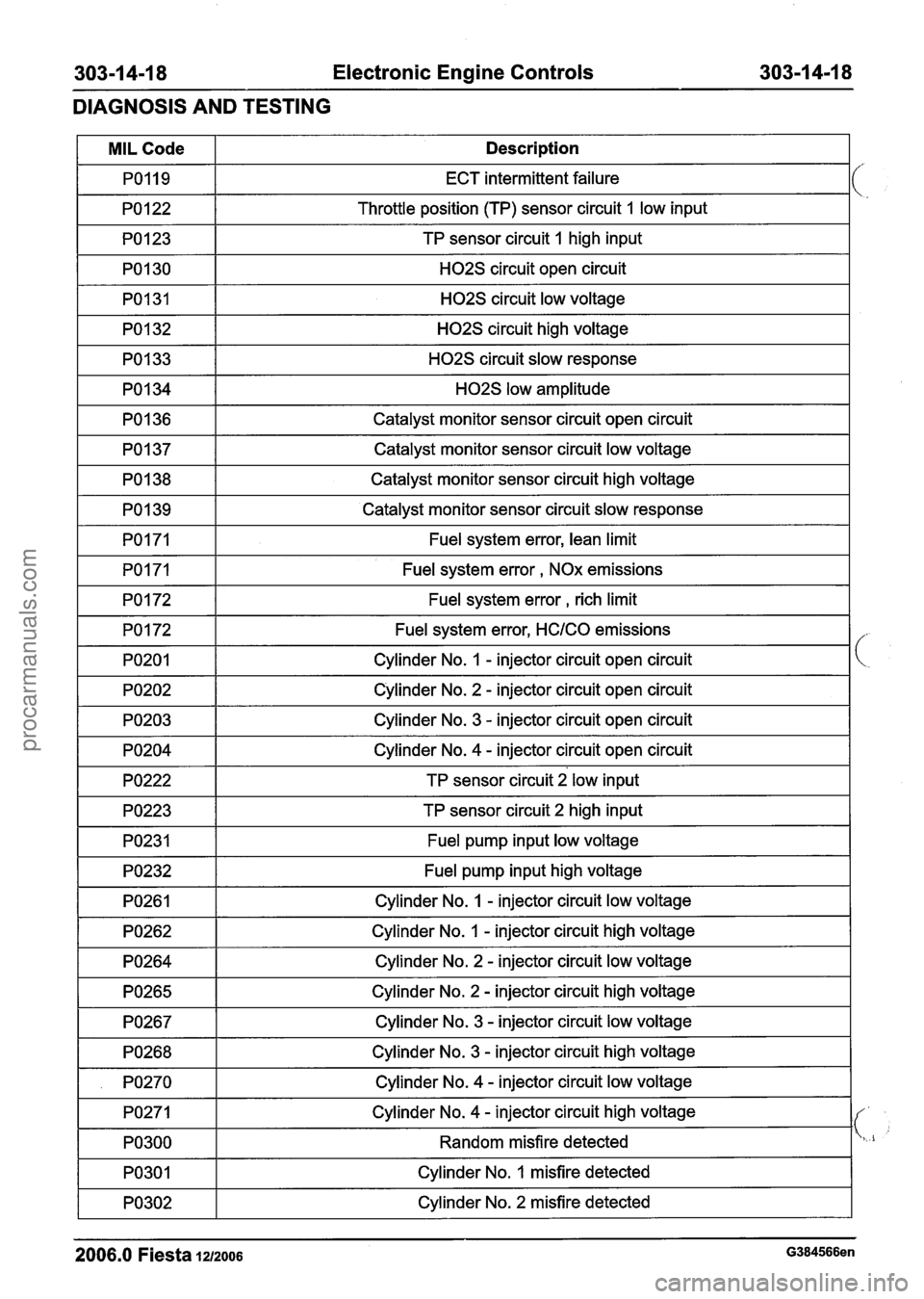
303-1 4-1 8 Electronic Engine Controls 303-1 4-1 8
DIAGNOSIS AND TESTING
I PO123 I TP sensor circuit I high input I
MIL Code
PO119
PO 1 22
I PO130 I H02S circuit open circuit I
Description
ECT intermittent failure
Throttle position
(TP) sensor circuit 1 low input
I PO131 I H02S circuit low voltage I
pol34 r- HO~S IOW amplitude I
PO1 32
PO1 33
I PO136 I Catalyst monitor sensor circuit open circuit I
H02S circuit high voltage
H02S circuit slow response
I PO137 I Catalyst monitor sensor circuit low voltage I
PO1 38
PO1 39
I PO172 I Fuel system error, rich limit I
Catalyst monitor sensor circuit high voltage
Catalyst monitor sensor circuit slow response
PO171
PO171
Fuel system error, lean limit
Fuel system error
, NOx emissions
PO172
PO201
I PO203 I Cylinder No. 3 - injector circuit open circuit I
Fuel system error, HClCO emissions
Cylinder No.
I - injector circuit open circuit
PO202
I PO204 I Cylinder No. 4 - injector circuit open circuit I
Cylinder No. 2 - injector circuit open circuit
-1 TP sensor circuit 2 low input I
1 PO223 1 TP sensor circuit 2 high input I
I PO231 I Fuel pump input low voltage I
PO232
PO261
Fuel pump input high voltage
Cylinder No.
1 - injector circuit low voltage
PO262
PO264
1 PO267 1 Cylinder No. 3 - injector circuit low voltage I
Cylinder No. 1 - injector circuit high voltage
Cylinder No.
2 - injector circuit low voltage
PO265
1 PO268 1 Cylinder No. 3 - injector circuit high voltage I
-- -
Cylinder No. 2 - injector circuit high voltage I
I . PO270 I Cylinder No. 4 - injector circuit low voltage I
PO271
PO300
Cylinder No. 4 - injector circuit high voltage
Random misfire detected
PO301
2006.0 Fiesta 1212006 G384566en
Cylinder No. 1 misfire detected
PO302
-- -
Cylinder No. 2 misfire detected
procarmanuals.com
Page 954 of 1226
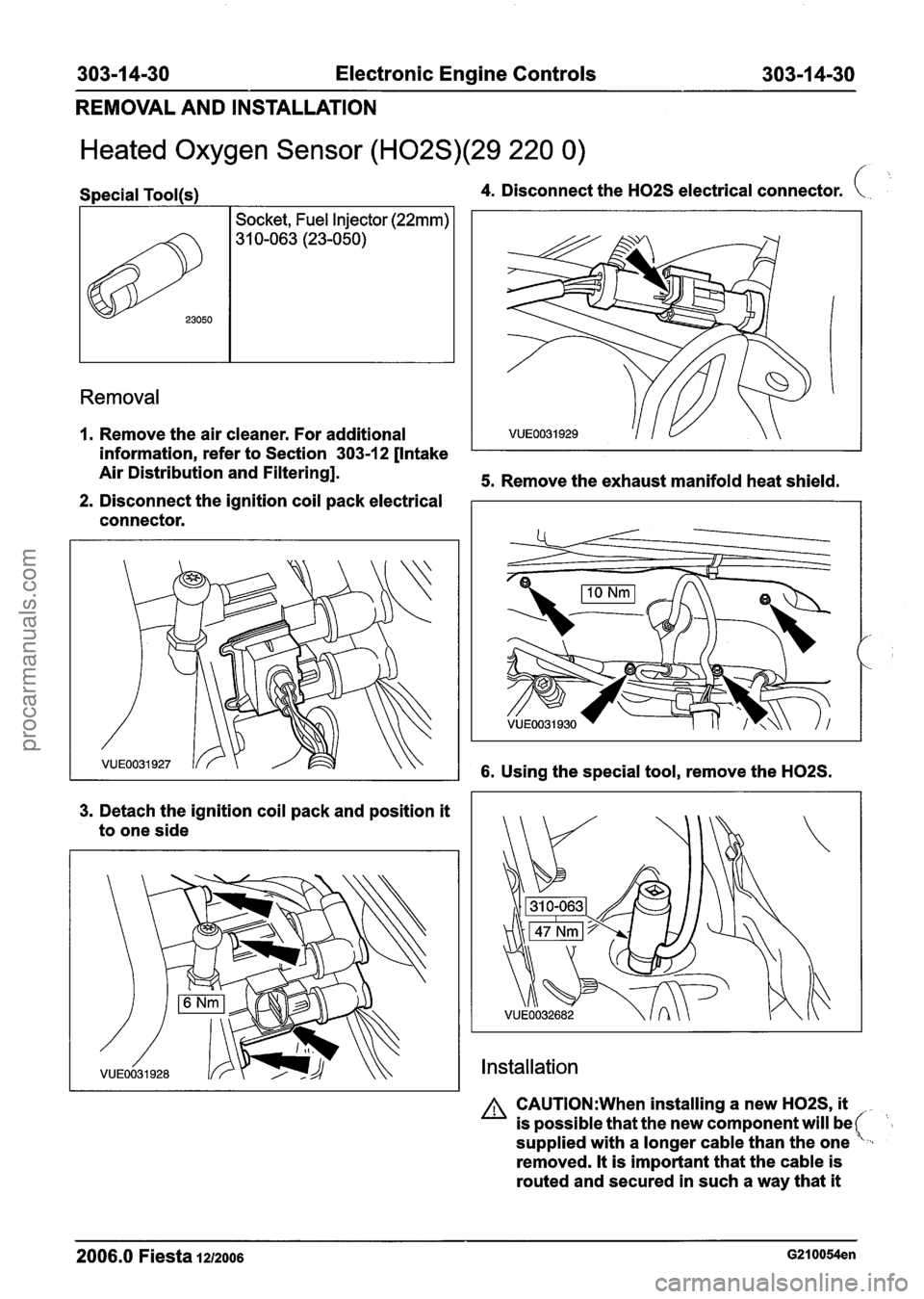
303-1 4-30 Electronic Engine Controls 303-1 4-30
REMOVAL AND INSTALLATION
Heated Oxygen Sensor (H02S)(29 220 0) /
Removal
Special Tool(s) 4. Disconnect the H02S electrical connector. (. .. >k,
1. Remove the air cleaner. For additional
information, refer to Section 303-1 2 [Intake
Air Distribution and Filtering].
5. Remove the exhaust manifold heat shield.
2. Disconnect the ignition coil pack electrical
connector.
23050
3. Detach the ignition coil pack and position it
to one side
Socket, Fuel Injector (22mm)
31 0-063 (23-050)
6. Using the special tool, remove the H02S.
Installation
A CAUTI0N:When installing a new H02S, it
is possible that the new component will be (- supplied with a longer cable than the one ,
removed. It is important that the cable is
routed and secured in such a way that
it
2006.0 Fiesta 1212006 G210054en
procarmanuals.com